Reminiscing
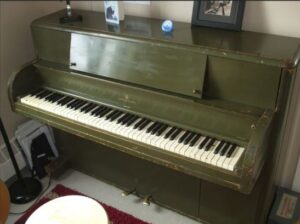 Production needs during wartime often change dramatically, and the piano industry was no exception. I suppose that such frivolous items as a piano, must go by the wayside when so many much more important things like weapons, military vehicles, and military airplanes were needed so much more. That is what you might logically think anyway. Nevertheless, you would be wrong. During World War II, the famous musical instrument company, Steinway and Sons, did stop making traditional pianos. The biggest reason for the change was because the materials they needed were shifted to the war effort. Still, the company didn’t shut down production entirely. They actually began making things that were needed for the war effort. Things like coffins and parts for military transports became the production like items of the day. It seemed a sad state of affairs for a company that had once brought so much joy and happiness to so many households and concert halls, but it had to be done, so they stepped up and did their part.
Production needs during wartime often change dramatically, and the piano industry was no exception. I suppose that such frivolous items as a piano, must go by the wayside when so many much more important things like weapons, military vehicles, and military airplanes were needed so much more. That is what you might logically think anyway. Nevertheless, you would be wrong. During World War II, the famous musical instrument company, Steinway and Sons, did stop making traditional pianos. The biggest reason for the change was because the materials they needed were shifted to the war effort. Still, the company didn’t shut down production entirely. They actually began making things that were needed for the war effort. Things like coffins and parts for military transports became the production like items of the day. It seemed a sad state of affairs for a company that had once brought so much joy and happiness to so many households and concert halls, but it had to be done, so they stepped up and did their part.
While they made many coffins and parts, strangely, Steinway was also contracted by the War Production Board 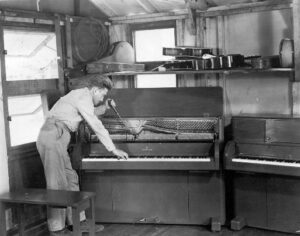 to make…pianos!! What?? The government wanted pians that could be set into battle, and when I think of shows like “MASH” with the piano that graced the “Officer’s Club,” that as it turned out, wasn’t just for officers, it makes perfect sense. What better way to boost moral than a piano that could be sent into battle. The new Steinway and Sons pianos were “small, sturdy uprights, painted olive drab and shipped by cargo vessels and transport planes to military theaters around the world.” Called “Victory Verticals” or “G.I. Steinways,” the company made about 3,000 of the pianos in 1942 and 1943. Some of the instruments were actually parachuted into camp complete with tuning tools and instructions. Now all it needed was a soldier who could play, and hopefully not just chop sticks. Others came in by Jeep on a wagon.
to make…pianos!! What?? The government wanted pians that could be set into battle, and when I think of shows like “MASH” with the piano that graced the “Officer’s Club,” that as it turned out, wasn’t just for officers, it makes perfect sense. What better way to boost moral than a piano that could be sent into battle. The new Steinway and Sons pianos were “small, sturdy uprights, painted olive drab and shipped by cargo vessels and transport planes to military theaters around the world.” Called “Victory Verticals” or “G.I. Steinways,” the company made about 3,000 of the pianos in 1942 and 1943. Some of the instruments were actually parachuted into camp complete with tuning tools and instructions. Now all it needed was a soldier who could play, and hopefully not just chop sticks. Others came in by Jeep on a wagon.
As the gifts made their strange arrivals, the men welcomed their arrival. Any camp that was blessed enough to receive a Victory Vertical felt an instant lift of their spirits. One US Army Private, Kenneth Kranes told his 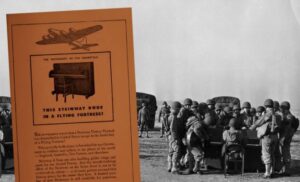 mother in a letter home from North Africa dated May 6, 1943, “Two nights past we received welcome entertainment when a Jeep pulling a small wagon came to camp. The wagon contained a light system and a Steinway pianna. It is smaller and painted olive green, just like the Jeep. We all got a kick out of it and sure had fun after meals when we gathered around the pianna to sing. I slept smiling and even today am humming a few of the songs we sang.” Who would have thought that a company so famed for its elegant musical instruments would find that quite possibly its most famous instrument would be a plain-Jane, olive-drab version of what it expected to be famous for.
mother in a letter home from North Africa dated May 6, 1943, “Two nights past we received welcome entertainment when a Jeep pulling a small wagon came to camp. The wagon contained a light system and a Steinway pianna. It is smaller and painted olive green, just like the Jeep. We all got a kick out of it and sure had fun after meals when we gathered around the pianna to sing. I slept smiling and even today am humming a few of the songs we sang.” Who would have thought that a company so famed for its elegant musical instruments would find that quite possibly its most famous instrument would be a plain-Jane, olive-drab version of what it expected to be famous for.
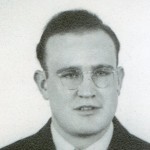
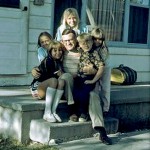 For Christmas, I gifted my grandson, Josh Petersen and his fiancée, Athena Salazar a Cribbage Board game. Since that time, I have been thinking a lot about my uncle, Bill Spencer, who taught me to play Cribbage when I was a kid. We had so many great times playing Cribbage together. Uncle Bill was a stickler for actually “teaching” me the game, without “giving” me the game. I always appreciated that about him, because I knew that when I won…I really won. Uncle Bill was a fair, and sometimes, as with his family history documents, brutally honest man. He didn’t take credit where it wasn’t due him, and he always gave fair and honest praise. I think I am a lot like him in that way. I like things to be fair, honest, and above board.
For Christmas, I gifted my grandson, Josh Petersen and his fiancée, Athena Salazar a Cribbage Board game. Since that time, I have been thinking a lot about my uncle, Bill Spencer, who taught me to play Cribbage when I was a kid. We had so many great times playing Cribbage together. Uncle Bill was a stickler for actually “teaching” me the game, without “giving” me the game. I always appreciated that about him, because I knew that when I won…I really won. Uncle Bill was a fair, and sometimes, as with his family history documents, brutally honest man. He didn’t take credit where it wasn’t due him, and he always gave fair and honest praise. I think I am a lot like him in that way. I like things to be fair, honest, and above board.
It’s hard for me to believe that my Uncle Bill has been in Heaven a little over 2 years now. He passed away on 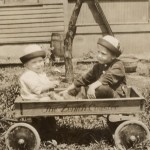
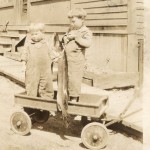 Christmas day, 2020. I didn’t see much of him toward the end, because he had dementia. Still, the times I saw him were such a treasure to me. The fact that he went home to Heaven didn’t really change very much in my life…physically, but it changed so much mentally. I always knew he was there, and while writing him a letter was out of the question, we were able to send him gifts that we knew he would enjoy…even though he wouldn’t know who sent them.
Christmas day, 2020. I didn’t see much of him toward the end, because he had dementia. Still, the times I saw him were such a treasure to me. The fact that he went home to Heaven didn’t really change very much in my life…physically, but it changed so much mentally. I always knew he was there, and while writing him a letter was out of the question, we were able to send him gifts that we knew he would enjoy…even though he wouldn’t know who sent them.
Uncle Bill was my favorite uncle. I loved all my uncles, of course, but Uncle Bill was like me…or, I was like him. I think my dad, Allen Spencer was a lot like his brother too. They were two of a kind…the Spencer boys. Always coming up with some new idea, even if it was a mischievous one. I can practically see God’s, for lack of a better word, reaction to Uncle Bill’s homecoming. My first reaction was, “Hide the dynamite!! The Spencer boys are 
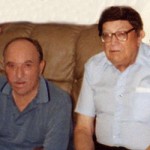 back together!!” Of course, if there is dynamite in Heaven, it will not be a destructive force, but I have no doubt that it will make a loud noise. The Spencer boys would love it if it did, so I’m sure God would make that arrangement…just for them. Today would have been my Uncle Bill’s 101st birthday. I think he would have loved that he almost made it to 100 years old. The only thing that would have pleased him more than 98, or almost 99 years, would have been 100 years. Happy birthday in Heaven, Uncle Bill. You boys be good and have a great party!! We love and miss you, very much.
back together!!” Of course, if there is dynamite in Heaven, it will not be a destructive force, but I have no doubt that it will make a loud noise. The Spencer boys would love it if it did, so I’m sure God would make that arrangement…just for them. Today would have been my Uncle Bill’s 101st birthday. I think he would have loved that he almost made it to 100 years old. The only thing that would have pleased him more than 98, or almost 99 years, would have been 100 years. Happy birthday in Heaven, Uncle Bill. You boys be good and have a great party!! We love and miss you, very much.
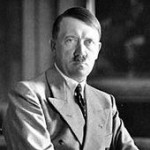
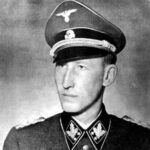 Anytime a government is going to pull off a big change, there must be meetings…planning meetings, if you will. The Third Reich, under Adolf Hitler had long wanted to literally remove the Jewish people from the face of the earth. They began making plans for what they called “The Final Solution to the Jewish Question” and later called the Wannsee Conference to ensure the co-operation of administrative leaders of various government departments in its implementation.
Anytime a government is going to pull off a big change, there must be meetings…planning meetings, if you will. The Third Reich, under Adolf Hitler had long wanted to literally remove the Jewish people from the face of the earth. They began making plans for what they called “The Final Solution to the Jewish Question” and later called the Wannsee Conference to ensure the co-operation of administrative leaders of various government departments in its implementation.
The Wannsee Conference was called by the director of the Reich Security Main Office SS-Obergruppenführer Reinhard Heydrich and included senior government officials of Nazi Germany and Schutzstaffel (SS) leaders. The conference was held in the Berlin suburb of Wannsee on January 20, 1942. The plan of the “Final Solution” was to deport most of the Jews of German-occupied Europe to occupied Poland, where they would be murdered. Hitler was obsessed with what he considered purifying the world. He wanted to build an Aryan race, which is “white non-Jewish people, especially those of northern European origin or descent typically having blond hair and blue eyes and regarded as a supposedly superior racial group.”
In the course of the meeting, Heydrich outlined how European Jews would be rounded up and sent to extermination camps in the General Government (the occupied part of Poland), where they would be killed. Of course, the meetings were merely a formality. The decisions had been made and they were not asking for the support of the attendees, but rather they were simply telling them what they would be doing…if they wanted to live, that is.
Hitler began his discrimination against Jews began immediately after the Nazi seizure of power on January 30, 1933. At first, he employed violence and economic pressure to encourage Jews to voluntarily leave the country. Sadly, the Jews thought that with compliance, they would be ok, but Hitler was determined to remove them from Germany…one way or the other. Then, after the invasion of Poland in September 1939, Hitler stepped up his plan for the extermination of European Jewry and began the killings.
The killings continued and accelerated after the invasion of the Soviet Union in June 1941. On July 31, 1941, Hermann Göring gave written authorization to Heydrich to “prepare and submit a plan for a ‘total solution of the Jewish question’ in territories under German control and to coordinate the participation of all involved government organizations.” At the Wannsee Conference, Heydrich emphasized that “once the deportation  process was complete, the fate of the deportees would become an internal matter under the purview of the SS. A secondary goal was to arrive at a definition of who was Jewish.” Basically, this meant that the Jewish deportees would simply “disappear” into thin air and never be heard from again. Just one copy of the “Protocol” with circulated minutes of the meeting survived the war. It was found by Robert Kempner in March 1947 among files that had been seized from the German Foreign Office. That copy was used as evidence in the subsequent Nuremberg trials. Like many other Holocaust sites, The Wannsee House is now a Holocaust memorial.
process was complete, the fate of the deportees would become an internal matter under the purview of the SS. A secondary goal was to arrive at a definition of who was Jewish.” Basically, this meant that the Jewish deportees would simply “disappear” into thin air and never be heard from again. Just one copy of the “Protocol” with circulated minutes of the meeting survived the war. It was found by Robert Kempner in March 1947 among files that had been seized from the German Foreign Office. That copy was used as evidence in the subsequent Nuremberg trials. Like many other Holocaust sites, The Wannsee House is now a Holocaust memorial.
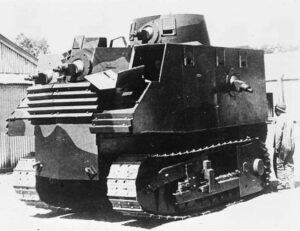 The making of the weapons of warfare is not always an easy task, and sometimes there is a lot of trial and error. When the different countries decided to begin making tanks, there were as many different styles as countries involved. That might sound like a good thing, but making an effective battle tank is no small undertaking, even in the best of times. Building one under the pressure of war is next to impossible. In fact, given the complexity of the machines, high costs, and stress of combat, I don’t know how they managed to make them work at all. Of course, not all tank designs were failures. There were a number of successful tanks, of course. If there hadn’t been we wouldn’t have tanks today. They would have just given up. Nevertheless, there were also a lot of failures.
The making of the weapons of warfare is not always an easy task, and sometimes there is a lot of trial and error. When the different countries decided to begin making tanks, there were as many different styles as countries involved. That might sound like a good thing, but making an effective battle tank is no small undertaking, even in the best of times. Building one under the pressure of war is next to impossible. In fact, given the complexity of the machines, high costs, and stress of combat, I don’t know how they managed to make them work at all. Of course, not all tank designs were failures. There were a number of successful tanks, of course. If there hadn’t been we wouldn’t have tanks today. They would have just given up. Nevertheless, there were also a lot of failures.
Tanks like the Bob Semple Tank, so named for the New Zealand politician tasked with designing it. Sadly, this dud was built with what limited materials or expertise, Semple and his team could get their hands on. The tank was designed after a picture on an American postcard. Basically, it was a tractor wrapped in steel with six 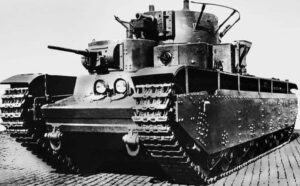 machine guns poking out at different angles. Ok, it might have looked like a tank, but that was about it. To change gear, it had to come to a complete stop…not a good way to ward off the enemy. One of the gunners of the eight-man crew had to lie on a mattress to squeeze into the cramped compartments, so he was pretty much done for it if the tank caught fire.
machine guns poking out at different angles. Ok, it might have looked like a tank, but that was about it. To change gear, it had to come to a complete stop…not a good way to ward off the enemy. One of the gunners of the eight-man crew had to lie on a mattress to squeeze into the cramped compartments, so he was pretty much done for it if the tank caught fire.
In true Hitler style, the Panzer VII Maus was the largest tank ever built. The size of the tank was its biggest downfall. The tank used too much fuel to be a logical option for a country running low on funds. In addition, the tank was so huge that it couldn’t maneuver through tree covered areas, and it was so slow that it couldn’t catch other tanks. It was also a sitting duck for aircraft looking to bomb it, because it just went so slowly.
The T-35, built in the Soviet Union, was the pride of the Red Army…until it was actually used in combat. This tank was outdated before it was built. A five-turret behemoth, it was a battleship on some seriously slow-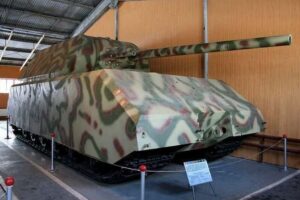 moving treads. About the only thing it was good for was looking good in a parade. On the field…well, that was another matter. The T-35 required a 10-man crew to operate and many more to maintain. More than half of the 48 tanks used in the first attack in 1941, broke down before reaching the front.
moving treads. About the only thing it was good for was looking good in a parade. On the field…well, that was another matter. The T-35 required a 10-man crew to operate and many more to maintain. More than half of the 48 tanks used in the first attack in 1941, broke down before reaching the front.
Of course, there were other duds too. Probably too many to mention here. The tank was a good idea, and the good ones were like a rolling force field. The problem was that the ones that were poorly designed, rather outnumbered the ones that were good. I suppose that is why there are relatively few tank designs.
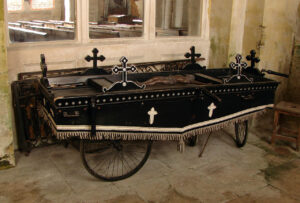
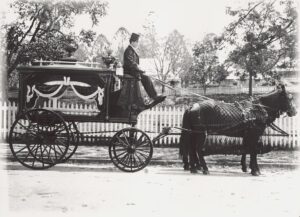 When the first cemeteries were set up, there were no automobiles, so the casket was transported by a horse or ox drawn wagon. This wasn’t exactly a luxury final ride to the final resting place, but I suppose the “honored guest” didn’t know the difference. Sometimes, when the deceased had lived way out in the country, the family chose to bury them on the property, but when they didn’t, the ride to the final resting place was a long one, and rather hard on the families, because it left so much time to just think. In many of these cases, the family had to build a casket before they could bury it. Planned funerals were very unusual. People didn’t often go to the undertaker and sit down to figure it all out, so the casket was also not planned. It gives a whole new perspective to the reason for waiting several days for the burial. We think there is a lot to plan these days…not really so much.
When the first cemeteries were set up, there were no automobiles, so the casket was transported by a horse or ox drawn wagon. This wasn’t exactly a luxury final ride to the final resting place, but I suppose the “honored guest” didn’t know the difference. Sometimes, when the deceased had lived way out in the country, the family chose to bury them on the property, but when they didn’t, the ride to the final resting place was a long one, and rather hard on the families, because it left so much time to just think. In many of these cases, the family had to build a casket before they could bury it. Planned funerals were very unusual. People didn’t often go to the undertaker and sit down to figure it all out, so the casket was also not planned. It gives a whole new perspective to the reason for waiting several days for the burial. We think there is a lot to plan these days…not really so much. 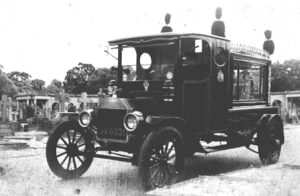
Hearses were originally “hand-drawn then horse-drawn after the decoration and weight of the hearse increased. The first electric motorized hearses were introduced to the United States in the early 1900s. Petrol-powered hearses began to be produced from 1907 and, after a slow initial uptake due to their high cost, became widely accepted in the 1920s. The vast majority of hearses since then have been based on larger, more powerful car chassis, generally retaining the front end up to and possibly including the front doors but with custom bodywork to the rear to contain the coffin.” On January 15, 1909, came the first use of an automobile hearse in a funeral.
While the first hearse was quite different from the hearses of today, it was really quite ornate. The hearses of today, might seem normal and average, but in some instances, they can be quite unusual too. One hearse I found, really surprised me. If you happen to be a motorcycle fan, you might be interested to know that there is actually a motorcycle hearse. It is a one rider affair, with a very interesting “sidecar” to hold the casket. It is a 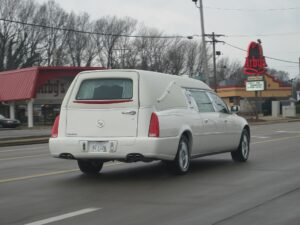
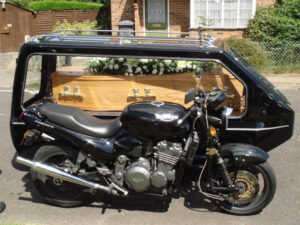 far cry from the original horse-drawn version, and definitely different from the hand cart version. While funerals these days are unique to the deceased, and that is what makes them beautiful, they were often very plain in times past. Everyone pretty much had the same service with the same songs, and the same words spoken. These days, funerals…planned mostly by the family, are very personalized, sometimes right down to the type of hearse.
far cry from the original horse-drawn version, and definitely different from the hand cart version. While funerals these days are unique to the deceased, and that is what makes them beautiful, they were often very plain in times past. Everyone pretty much had the same service with the same songs, and the same words spoken. These days, funerals…planned mostly by the family, are very personalized, sometimes right down to the type of hearse.
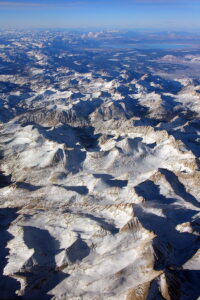
 Because I love to hike, I am always interested when I see something about a trail I’ve never been on. I can’t say that I’ve hiked an extensive number of trails, but most trails interest me anyway. Sometimes it’s just the area of the country, and my imagination kicking into high gear.
Because I love to hike, I am always interested when I see something about a trail I’ve never been on. I can’t say that I’ve hiked an extensive number of trails, but most trails interest me anyway. Sometimes it’s just the area of the country, and my imagination kicking into high gear.
The Sierra Nevada is a mountain range in the Western United States, located between the Central Valley of California and the Great Basin, with most of it located in the state of California, although the Carson Range spur lies primarily in Nevada. The Sierra Nevada is part of the American Cordillera, an almost continuous chain of mountain ranges that forms the western “backbone” of the Americas. There are literally miles and miles of trails leading to such famous places as Yosemite Valley, King’s Canyon, and Sequoia. Yosemite is the most famous one, and probably the one I would most like to hike. Pictures of the falls often grace the internet as people love the challenge of the hike to Yosemite Falls.
The Sierra Nevada runs 400 miles north-south and approximately 70 miles east–west. Besides the mountain tops, waterfalls, trails, and rivers, the area also boasts the largest tree in the world by volume, known as  General Sherman; Lake Tahoe, the largest alpine lake in North America; Mount Whitney at 14,505 feet the highest point in the contiguous United States; and of course, Yosemite Valley sculpted by glaciers from one-hundred-million-year-old granite, containing high waterfalls. The 28,000 square mile mountain range is home to three national parks, twenty wilderness areas, and two national monuments. These areas include Yosemite, Sequoia, and Kings Canyon National Parks, and Devil’s Postpile National Monument. Many of these places are not accessible by roads, although many are. Still from a hiker’s standpoint, these places are much more interesting if they are approached by trail.
General Sherman; Lake Tahoe, the largest alpine lake in North America; Mount Whitney at 14,505 feet the highest point in the contiguous United States; and of course, Yosemite Valley sculpted by glaciers from one-hundred-million-year-old granite, containing high waterfalls. The 28,000 square mile mountain range is home to three national parks, twenty wilderness areas, and two national monuments. These areas include Yosemite, Sequoia, and Kings Canyon National Parks, and Devil’s Postpile National Monument. Many of these places are not accessible by roads, although many are. Still from a hiker’s standpoint, these places are much more interesting if they are approached by trail.
During the years when people headed west to look for gold, the Sierra Nevada was often the destination of choice. Nevertheless, at that time, traveling across the wild west was very dangerous. Many rich travelers had to hire armed men to protect them on dangerous routes. Thankfully that is not the case today, although, there could be times when we feel the need for armed guards. Nevertheless, I have found that on most trails, people 
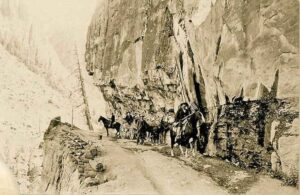 are friendly and kind. Of course, there are always the wild animals, which I have never come across on a trail…perhaps strangely, but true, nevertheless. The biggest “problem animal” I have ever come across was a few cows, who decided that they didn’t want to get off the trail for these strange creatures to pass them. I finally had to slap my hands together, after which, they decided that I was the dangerous one, and they left. One of these days, maybe I will have the opportunity to hike up to Yosemite Falls. I think I would really enjoy it.
are friendly and kind. Of course, there are always the wild animals, which I have never come across on a trail…perhaps strangely, but true, nevertheless. The biggest “problem animal” I have ever come across was a few cows, who decided that they didn’t want to get off the trail for these strange creatures to pass them. I finally had to slap my hands together, after which, they decided that I was the dangerous one, and they left. One of these days, maybe I will have the opportunity to hike up to Yosemite Falls. I think I would really enjoy it.
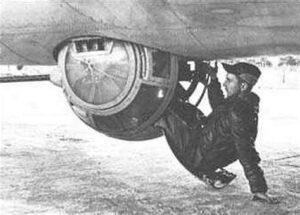
 There are many heroes is a war, and World War II is no exception. Because my dad, Allen Spencer served on a B-17, and was a Flight engineer and Top Turret Gunner, I have always had a special spot in my heart for the Flying Fortress. After all it is the plane that safely brought my dad back from the war so he could be my dad. Most people, who know anything about the B-17, know that the most dangerous station on the B-17 is the Ball Turret. In fact, the average life span of a ball turret gunner in battle is 12 seconds…seriously!! The bad thing for the ball turret gunner is that because it is a small space, the job goes to the smallest man in the group, and if there isn’t anyone who is 5’7″ or shorter, they have to find one. That is basically how Frank Perez ended up in that spot. It was very unexpected, because he trained in Biloxi, Mississippi at the B-24 training base, so it was expected that he would be assigned to a B-24.
There are many heroes is a war, and World War II is no exception. Because my dad, Allen Spencer served on a B-17, and was a Flight engineer and Top Turret Gunner, I have always had a special spot in my heart for the Flying Fortress. After all it is the plane that safely brought my dad back from the war so he could be my dad. Most people, who know anything about the B-17, know that the most dangerous station on the B-17 is the Ball Turret. In fact, the average life span of a ball turret gunner in battle is 12 seconds…seriously!! The bad thing for the ball turret gunner is that because it is a small space, the job goes to the smallest man in the group, and if there isn’t anyone who is 5’7″ or shorter, they have to find one. That is basically how Frank Perez ended up in that spot. It was very unexpected, because he trained in Biloxi, Mississippi at the B-24 training base, so it was expected that he would be assigned to a B-24.
Frank expected to be assigned to a B-24 crew but due to the “needs of the service,” Frank was assigned to the Lieutenant John J Connolly crew of a B-17 Flying Fortress. The B-17 crew already had a flight engineer, so Frank was selected for the ball turret gunner position. Knowing what I know about the ball turret gunner and knowing that anyone who knew about the B-17 also knew about the life span of a ball turret gunner, I’m quite sure that Perez instantly felt just a little bit sick to his stomach…a feeling that would be justified later. Perez had to fly for a time with a different crew while his crew finished some training. Then, he contracted pneumonia, and he was down for a month.
Finally, on July 28, 1944, Perez started flying with his crew again. Their target was the synthetic oil and ammonia plant at Merseburg, Germany. As we know, all combat missions were dangerous, but for Perez, this particular mission to Ludwigshaven, Germany, would really test his faith. Ludwigshaven was the site of large marshalling (railway) yards and a railroad depot. When the bombing run was completed, the B-17s headed back to their base in England. One of the most dangerous parts of a bombing run is maneuvering through the anti-aircraft guns with their flak. Frank’s B-17 was hit by flak and began tumbling and rolling out of control as it quickly lost altitude from about 30 thousand feet. The plane was still over Germany, and Perez could not get out of the ball turret due to the centrifugal force created as the plane fell from the sky. All he could do is watch in horror as the ground got closer and closer. He called the pilot on the intercom. No answer. Then he called “anyone.” No answer. He had to assume that he was the only survivor left…and that would not be for long.
Perez was sure that his life was over, so he started to pray. He prayed, “Well, God, if this is the way it has to be, let it be.” It was a noble prayer, but as he said, “I was under tension and wanted to live. But when I said that, at that instant, everything was just as peaceful as it can get. [I] had my whole life flash before me…from the time I was a little kid to that moment. I mean just like a movie but going like that [he snaps his fingers]. It’s hard to explain…like if you get killed, so what…you just don’t care.” It was his way of resigning himself to his fate and, then…the B-17 pulled up.
The flak might have knocked them out, and some were likely injured, but they were alive. The plane flew in at treetop level with only two of the four engines working. The crew, in an effort to lighten the load, began throwing unnecessary equipment and supplies out of the plane. Perez was still in the ball turret, as he had been for the entire mission. Finally, he saw the White Cliffs of Dover on the English coastline and knew that they 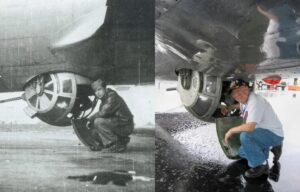
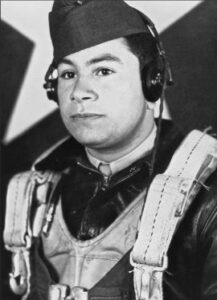 were going to make it. The B-17 was able to land at a B-24 base in England, where it was repaired.
were going to make it. The B-17 was able to land at a B-24 base in England, where it was repaired.
After completing his required combat missions, Perez was discharged and sailed home to the United States. He was back in the US before December 16, 1944. Surviving the ball turret was the saving grace for Perez, who went on to live a long and fruitful life. He died January 16, 2015, two days after his 91st birthday.
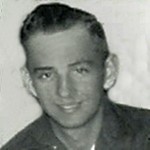 My uncle, Wayne Byer has always been a hardworking man. Even in his retirement years, he likes to stay busy. In fact, he might be on the go more, now that his is retired, than he was before. That isn’t so unusual really. When I retired, my activities have multiplied…almost taken on a mind of their own. Uncle Wayne has been much that way too, but he retired long before I did, so his activities list is most likely much bigger than mine. He likes tinkering in his garage, making things, and repairing things. It gives him a sense of satisfaction.
My uncle, Wayne Byer has always been a hardworking man. Even in his retirement years, he likes to stay busy. In fact, he might be on the go more, now that his is retired, than he was before. That isn’t so unusual really. When I retired, my activities have multiplied…almost taken on a mind of their own. Uncle Wayne has been much that way too, but he retired long before I did, so his activities list is most likely much bigger than mine. He likes tinkering in his garage, making things, and repairing things. It gives him a sense of satisfaction.
Uncle Wayne Being a mechanic at the school bus garage, and later the head of the school bus garage, he was tasked with making sure that every bus was in good repair, 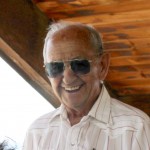 so that the busses would all transport the children safely to their destination. Because we lived in town, my sisters and I didn’t have to ride the bus to school. Later, because my husband, Bob and I lived in the country when our girls were little, they took the bus to school every day. It was then that I really understood just how important my Uncle Wayne’s work was. Nothing brings safety home to you like having your kids be the ones who are being kept safe. And that’s what my uncle did…kept my kids safe, by making sure the busses were safe. My girls always liked the fact that their great uncle took care of the school buses they rode. I think they also liked it when they could tell people that it was their great uncle who headed up the garage. They were very proud of what he did.
so that the busses would all transport the children safely to their destination. Because we lived in town, my sisters and I didn’t have to ride the bus to school. Later, because my husband, Bob and I lived in the country when our girls were little, they took the bus to school every day. It was then that I really understood just how important my Uncle Wayne’s work was. Nothing brings safety home to you like having your kids be the ones who are being kept safe. And that’s what my uncle did…kept my kids safe, by making sure the busses were safe. My girls always liked the fact that their great uncle took care of the school buses they rode. I think they also liked it when they could tell people that it was their great uncle who headed up the garage. They were very proud of what he did.
Uncle Wayne always had a soft spot for kids. He loved to make them laugh and they loved his jokes. I 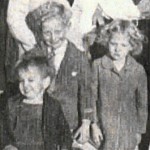 remember, as a kid when he would pop his dentures out All of the kids tried really hard to do the same. We really thought there must be some trick to it…at least until we got older. Uncle Wayne loved to laugh and was always such a happy guy. It totally endeared him to all of us. Looking back on my childhood, Uncle Wayne is in many of my fondest memories. He was my mother, Collene Spencer’s younger brother, and the third in their mischievous three. Together with their brother, Larry Byer, these three managed to get under Grandma Byer’s skin more than any of the others, most of the time anyway. Nevertheless, she loved all nine of her children…even her mischievous middle three. Today is Uncle Wayne’s 85th birthday. Happy birthday Uncle Wayne!! Have a great day!! We love you!!
remember, as a kid when he would pop his dentures out All of the kids tried really hard to do the same. We really thought there must be some trick to it…at least until we got older. Uncle Wayne loved to laugh and was always such a happy guy. It totally endeared him to all of us. Looking back on my childhood, Uncle Wayne is in many of my fondest memories. He was my mother, Collene Spencer’s younger brother, and the third in their mischievous three. Together with their brother, Larry Byer, these three managed to get under Grandma Byer’s skin more than any of the others, most of the time anyway. Nevertheless, she loved all nine of her children…even her mischievous middle three. Today is Uncle Wayne’s 85th birthday. Happy birthday Uncle Wayne!! Have a great day!! We love you!!
 We have come to expect apartment buildings to look pretty much the same. There might be a few structural differences, but basically the idea is small homes stacked on top of each other, so that multiple families can be housed is a relatively small space. These days I have seen more buildings that look almost like very large houses, mansions even, but the reality is that they buildings house many families, and the apartments are rather cookie-cutter and plain.
We have come to expect apartment buildings to look pretty much the same. There might be a few structural differences, but basically the idea is small homes stacked on top of each other, so that multiple families can be housed is a relatively small space. These days I have seen more buildings that look almost like very large houses, mansions even, but the reality is that they buildings house many families, and the apartments are rather cookie-cutter and plain.
One building…the Waldspirale, which means forest spiral in English, is not just another random residential building. Designed by Friedensreich  Hundertwasser, this architectural wonder located in Darmstadt in Germany. Construction began at the end of 1990s and was completed in 2000. This building is no ordinary structure. The U-shape of the building is characterized by unique multicolored facade and lack of straight lines. The plan was to make sure that no other building looked quite like this one. The inside of the building is just as unique as the outside. The inner wall corners are rounded to match the outer walls of the building. The building has 105 apartments, a garage, and a playground for children…with a tiny artificial lake…much more than the average apartment building in the 90s. The building is really irregularly shaped, and while it seems short, the highest point of the building goes up to the 12th floor. That is all interesting, but what I find the most interesting is that not one of the 1000 windows in the building are the same and the handles on the doors are also different. Imagine just finding 1000 different windows and probably as many different doors too.
Hundertwasser, this architectural wonder located in Darmstadt in Germany. Construction began at the end of 1990s and was completed in 2000. This building is no ordinary structure. The U-shape of the building is characterized by unique multicolored facade and lack of straight lines. The plan was to make sure that no other building looked quite like this one. The inside of the building is just as unique as the outside. The inner wall corners are rounded to match the outer walls of the building. The building has 105 apartments, a garage, and a playground for children…with a tiny artificial lake…much more than the average apartment building in the 90s. The building is really irregularly shaped, and while it seems short, the highest point of the building goes up to the 12th floor. That is all interesting, but what I find the most interesting is that not one of the 1000 windows in the building are the same and the handles on the doors are also different. Imagine just finding 1000 different windows and probably as many different doors too.
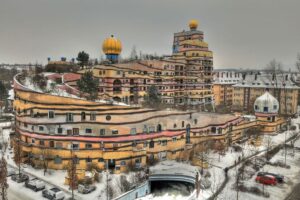 While it was designed by Austrian artist Friedensreich Hundertwasser, it was planned and implemented by architect Heinz M Springmann and constructed by the Bauverein Darmstadt company. I’m sure the uniqueness of the building, while somewhat simple to design, would take a lot of planning and the structure would take some special planning to make it stable enough to carry out the structure as it was designed the uniqueness of the plan. Since I, like many other people have watched the DIY channels, I know that the more unique the structure the more work goes into making it stable. While some people might consider it weird to live in such a building, I think it might be kind of fun.
While it was designed by Austrian artist Friedensreich Hundertwasser, it was planned and implemented by architect Heinz M Springmann and constructed by the Bauverein Darmstadt company. I’m sure the uniqueness of the building, while somewhat simple to design, would take a lot of planning and the structure would take some special planning to make it stable enough to carry out the structure as it was designed the uniqueness of the plan. Since I, like many other people have watched the DIY channels, I know that the more unique the structure the more work goes into making it stable. While some people might consider it weird to live in such a building, I think it might be kind of fun.

 Is it art or is it an exercise machine? I suppose it depends on your perspective. The strange staircase that doubles as a beautiful piece of art is located in the courtyard of an office building in Munich, hidden from public view for the most part. At first glance, it looks like a spiral staircase that is…just a little bit odd looking…like it’s a double staircase. Then a staircase seemingly leads you up…to nowhere, aaround and back to the bottom again. “Umschreibung” is not really a staircase at all. It’s actually an ominous sculpture by Danish artist Olafur Eliasson. “Umschreibung” is a German word which means “euphemism,” or “circumlocution,” the second of these made sense to me because the structure is repetitive, but the first definition didn’t, because an alternative just didn’t fit. The “Umschreibung” web site translates it to “circumscription” or “periphrasis,” meaning “a movement without destination, a space defined by motion rather than walls.” That idea is interesting and much like exercise equipment, because that is what a treadmill or exercise bike does.
Is it art or is it an exercise machine? I suppose it depends on your perspective. The strange staircase that doubles as a beautiful piece of art is located in the courtyard of an office building in Munich, hidden from public view for the most part. At first glance, it looks like a spiral staircase that is…just a little bit odd looking…like it’s a double staircase. Then a staircase seemingly leads you up…to nowhere, aaround and back to the bottom again. “Umschreibung” is not really a staircase at all. It’s actually an ominous sculpture by Danish artist Olafur Eliasson. “Umschreibung” is a German word which means “euphemism,” or “circumlocution,” the second of these made sense to me because the structure is repetitive, but the first definition didn’t, because an alternative just didn’t fit. The “Umschreibung” web site translates it to “circumscription” or “periphrasis,” meaning “a movement without destination, a space defined by motion rather than walls.” That idea is interesting and much like exercise equipment, because that is what a treadmill or exercise bike does.
The 30-foot-tall sculpture is made of steel. Basically, it is a staircase in the shape of a double helix. At the bottom of the staircase there is a small opening. It’s just the right size for an entrance, so you can actually climb the stairs yourself. I don’t know if that is allowed now or not, but it looks like it was once or is 
 sometimes. The view I saw of it has a small chain on each side of the entrance as a way of closure. If it is not allowed, I think it is a really sad thing. A staircase is meant to be climbed. The “Endless Staircase” is, as I said, located in the courtyard of an office building, and I suppose that the people who work in those offices would eventually get used to the beautiful structure just outside the window, but for me, I think I might have trouble with my imagination…especially if I was allowed to climb it once. I would want to climb it every day, maybe several times a day. There is just something about the idea of climbing a stairway that doesn’t end.
sometimes. The view I saw of it has a small chain on each side of the entrance as a way of closure. If it is not allowed, I think it is a really sad thing. A staircase is meant to be climbed. The “Endless Staircase” is, as I said, located in the courtyard of an office building, and I suppose that the people who work in those offices would eventually get used to the beautiful structure just outside the window, but for me, I think I might have trouble with my imagination…especially if I was allowed to climb it once. I would want to climb it every day, maybe several times a day. There is just something about the idea of climbing a stairway that doesn’t end.
The structure was designed and built by a man named Olafur Eliasson, who is an Icelandic–Danish artist known for sculptured and large-scale installation art employing elemental materials such as light, water, and air temperature to enhance the viewer’s experience. He was born in Copenhagen on February 5, 1967, to Elías Hjörleifsson and Ingibjörg Olafsdottir. After his parents divorced when he was 8, he lived with his mother and his stepfather, a stockbroker. His father, who was by then an artist, moved back to Iceland, where their family 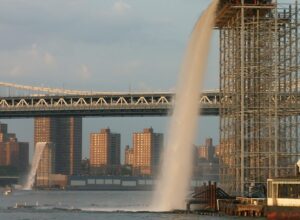
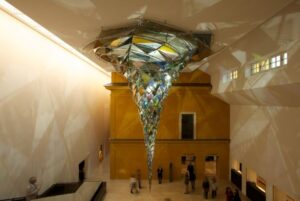 spent summers and holidays. Taking after his father, Olafur had his first solo show at 15, exhibiting landscape drawings and gouaches at a small alternative gallery in Denmark. From there, his work grew and expanded into abstracts, which is where his fame came from. The “Umschreibung” was designed and built in 2004. Another of his cool structures is the New York City Waterfalls, and there are many others too.
spent summers and holidays. Taking after his father, Olafur had his first solo show at 15, exhibiting landscape drawings and gouaches at a small alternative gallery in Denmark. From there, his work grew and expanded into abstracts, which is where his fame came from. The “Umschreibung” was designed and built in 2004. Another of his cool structures is the New York City Waterfalls, and there are many others too.

